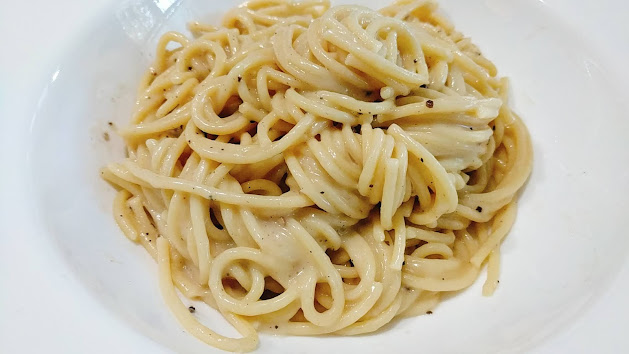If you've been to Rome, and came back and tried this out based on the instruction you've heard from Rome, odds are you've had a couple batches that looked nothing like the creamy, smooth, luscious goodness that allegedly was achievable with just cheese and pasta water, with no cream or butter.
Nothing says "simple does not equal easy" as loudly as Cacio e Pepe. Not even the infamously temperamental soft scrambled eggs, because honestly, slightly over cooked eggs are still pretty tasty if you're not being snooty, but lumpy, unemulsified Cacio e Pepe is genuinely not enjoyable, aside from being entirely not presentable.
To avoid wasting food, I've "cheated" with butter, oil, cream, even a béchamel sauce to salvage the lumpy pasta. But a tasty mac and cheese is no Cacio e Pepe. The taste of Rome can only be achieved with the traditional simple ingredients the recipe calls for: pecorino, pepper, pasta, plus salt & water that the pasta is cooked in. - Or their chemical equivalent.
To understand the failures, you need to understand why the successful ones work. The answer is starch starch starch. Water and fat don't mix. The emulsifier in the traditional recipes is the very starchy water. The higher the starch content of your pasta water, the easier your cheese will emulsify.
 You can use higher quality pasta and more premium cheese for a marginal difference in ease of emulsification, but the real key is in the pasta water. That's why one common advice you find online is to cook pasta in shallow water. While grounded in good reasons, I have not found that to be fail-safe, especially with less-than-premium pasta.
You can use higher quality pasta and more premium cheese for a marginal difference in ease of emulsification, but the real key is in the pasta water. That's why one common advice you find online is to cook pasta in shallow water. While grounded in good reasons, I have not found that to be fail-safe, especially with less-than-premium pasta.
Reducing small portion pasta water just before emulsification helps tremendously, but it takes time & experience, to eyeball what is the right viscosity, that indicates a good starch level for the sauce. You also risk getting a final result that is too salty, since pasta water is often already generously salted to "taste like the sea", and the reduction process will amplify the saltiness.
After trying all the common fixes found on the internet, it dawned on me to just use wheat starch. Why go through all the hassle to get starchier water when we can just introduce the starch, cheap and easy. I'm using wheat starch to stay chemically true to tradition. It also happens to work better for emulsification than corn starch, which, while doable in a pinch, doesn't create as smooth a sauce. If you don't have wheat starch (or any purist friends to appease), any other starch will basically work, although wheat starch will be the one that tastes closest to the real deal. You can use as much water as you like to boil your pasta; no large pan needed, and no guesswork involved!- 4oz spaghetti
- 2oz pecorino
- 1 tsp whole black pepper
- 1 tsp wheat starch
- 1 tbsp cold water
- salt
- cooking water
Instruction:
 Boil pasta in generously salted water according to package instruction. Dissolve the wheat starch with cold water. Finely grate the pecorino. 3~5 minutes before the pasta finishes cooking, start toasting whole black pepper in a pan, until you can smell it (~30 seconds). Grind the whole pepper with mortar and pestle, and return the ground pepper to the pan. Add about 1/4 inch of pasta water to the pan, along with all the pasta; turn up the heat to keep the water bubbling. Add the dissolved wheat starch to the pan, heat until pasta water thickens. Add ~1/4 cup of hot pasta water to the grated pecorino; stir to form a thick paste. Add the cheese paste to the starchy pasta; stir until fully emulsified & sauce is creamy and smooth. Reduce the sauce to your liking if needed. Enjoy!
Boil pasta in generously salted water according to package instruction. Dissolve the wheat starch with cold water. Finely grate the pecorino. 3~5 minutes before the pasta finishes cooking, start toasting whole black pepper in a pan, until you can smell it (~30 seconds). Grind the whole pepper with mortar and pestle, and return the ground pepper to the pan. Add about 1/4 inch of pasta water to the pan, along with all the pasta; turn up the heat to keep the water bubbling. Add the dissolved wheat starch to the pan, heat until pasta water thickens. Add ~1/4 cup of hot pasta water to the grated pecorino; stir to form a thick paste. Add the cheese paste to the starchy pasta; stir until fully emulsified & sauce is creamy and smooth. Reduce the sauce to your liking if needed. Enjoy!



Casinos Near Me | Jtm Hub
ReplyDeleteFind the 대구광역 출장안마 closest 서귀포 출장안마 Casinos near you in one place! Search thousands of the best Casinos Near you in 여주 출장안마 one place! 정읍 출장마사지 Use our powerful search tool to find 충주 출장마사지 the best casinos with